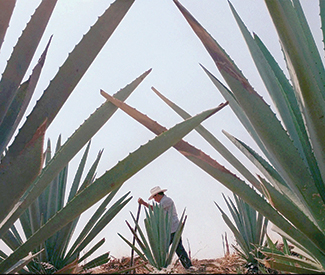When it comes to tasting mezcal, the experts have some generally accepted rules. Chief among them is that “you should never taste more than four together,” cautioned Oaxaca’s Graciela Carreño of Mezcal Real Minero at the Mezcal: Mexico In a Bottle event, held at Public Works, Sept. 14. It’s usually good advice: With the spirit’s alcohol content regularly topping 50 percent ABV, and its flavor components so nuanced yet so varied from one bottle to the next, it can be hard to distinguish mezcal’s finer points when your tastebuds are aflame with intense spice, smoke, and minerality.
But when you’re staring down nearly 20 of the world’s absolute best mezcal brands in one room, each of which has at least three or four different offerings on hand (if not plenty more), heeding that first caveat is a patent impossibility.
Events like Mexico In a Bottle are not everyday happenings in the US, so for mezcal aficionados and fans, this was something of a paradise. It wasn’t until the next day that I could even hazard a guess as to how many different mezcals I tasted over the course of those four hours, but it’s somewhere in the neighborhood of 40. I, naturally, was not the only one on such a course.
At a table helmed by Arik Torren of Fidencio Mezcal and Esteban Morales, who was properly introducing La Venenosa Raicilla to the US for the first time that night, there were no fewer than 13 expressions to taste — from basic espadín to pechuga distilled with fruits and raw chicken breast to wild-grown madrecuixe to single-distilled Jaliscan raicilla that started off with an almost cheese-like scent before moving into sweeter flavors. All of them were sublime.
Another bit of advice? Mezcal should be “kissed,” rather than drank, but when one considers the blood, sweat, and centuries of callouses that mark these magical hand-made elixirs’ travels from Mexican hillsides to our mouths in a club off of Mission Street, spitting or pouring out your leftovers seems at least guilt-inducing, if not downright shameful. You can see where this is going: No matter how little you kiss, there’s a good chance you leave feeling pretty fucked up.
That wasn’t, of course, the first order of business. It was to simply explore the plentitude of offerings — the explosively tasty spirits from relative newcomers like Mezcal Tosba, La Niña Del Mezcal, and El Jolgorio to the more widely distributed Del Maguey and Mezcal Vago brands. Local restaurants such as Sabrosa, Tamarindo, Loló, and La Urbana also created special mezcal-based cocktails for the celebration, and paired them with small bites.
Upstairs, Max Garrone (who, along with his Mezcalistas.com co-author, Susan Coss, organized the event) hosted a panel discussion with Morales and Wahaka Mezcal’s Raza Zaidi on the history and culture of the spirit, and others like Carreño, Montelobos creator Iván Saldaña, and writer John McEvoy (aka the Mezcal PhD) walked guests through guided tastings. As the evening progressed, and more folks willfully discarded any recommendations of restraint, those informative tastings became less and less formal, to the point where the crowds’ attention was even a little hard to corral — which made for even livelier and more interactive samplings.
Of course, one of the most exciting elements of an event like this is getting your lips on super-unique bottlings heretofore unknown and unavailable in the US. Along with La Venenosa’s debut, Wahaka also premiered its soon-to-be-released line of vegan pechuga mezcals, which involves placing a bag of herbs (Espadín Botaniko) or heirloom apples (Espadín Manzanita) in the still during the spirit’s second distillation.
Mexico City’s Erick Rodriguez, who is known as the Indiana Jones of Mezcal, because of his extreme forays out into the mountains and pueblos in search of the rarest of the rare, also presented a few gems that he sourced for the Oaxaca-based brand/tasting room Mezcaloteca, along with some from his own Almamezcalera line. Due to their extremely small runs and primitive production methods — which can include wild-harvesting and hand-mashing the agave, and fermenting it in leather sacks or hollowed-out tree trunks — many of the mezcals he finds will forever remain in the collectors-only realm, but damn, they’ve got character.
While pondering the larger issues surrounding this oft-misunderstood and mistreated spirit was a big part of why people came to Mezcal: Mexico In a Bottle, it was also, of course, to celebrate its legacy, its cultural importance, and its vibrancy. Mezcal has inspired a cult-like following that only seems to be growing, and while it may be at a crossroads in terms of its sustainability, it’s clearly got a huge support network that has spread well beyond the borders of Oaxaca to points all around the world– one of the biggest of which is, without a doubt, San Francisco. As some of the brand reps echoed during one panel, with an increase in consumer awareness like we’re seeing, there is hope for mezcal despite its current socio-economic challenges. And events like this one can only help.

